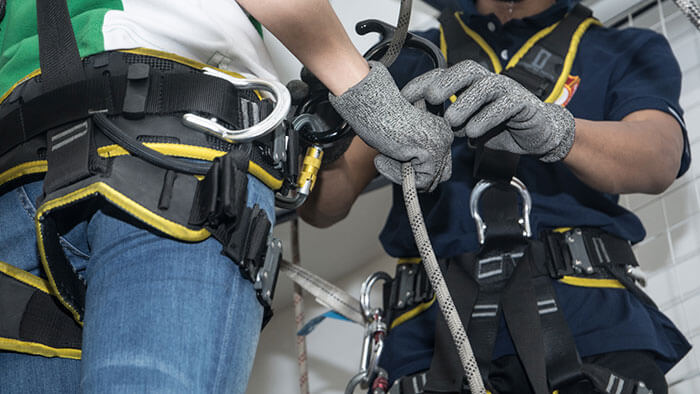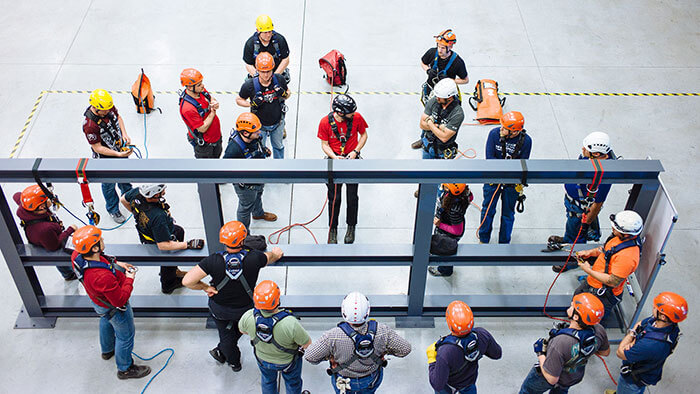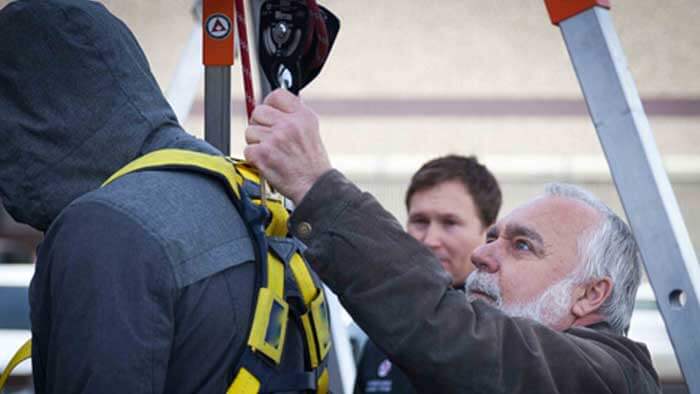Working on a Project? Contractor and Constructor Obligations
Jul 05, 2021 Safety Training, Working at HeightsIf you have ever taken one of our training courses, or any course really, the introductions are always done at the beginning.
Now, some instructors take the time to regale the participants with war stories pertinent to the topic at hand, while other cut to the point and just chronicle their personal background history. It doesn’t matter, in the end – it is all to establish credibility with the participants.
When I teach courses, my introduction is beyond brief.
Usually along the lines of, “I’m Geoff, and I’ve been doing this just long enough to pretend that I know what I’m doing.” My manager loves that, by the way. I do this not because I don’t care, but because I am most certainly not the focus of the course.
The material is the focus and how it relates to the participants. I want to know who you are, what you do, and your experience level with the topic. Then I can apply some adult learning principles and 4 stages of competence to see where we have to go from there.
One of my favourite answers to those questions always occurs during a construction course. More specifically, a Working at Heights course.
It is not uncommon that the participants have zero experience with harnesses.
They are solely in that course as a requirement for being on-site. In fact, I have had many workers claim that it is a waste of their time when they can be working and actually making money that day.
So why bother with it all? Easy, we need to be compliant and we need to stay safe, because we all want to go home at the end of the day alive.

Contractor & Constructor Safety Compliance
If you look up in your handy-dandy, green book – flip over to the Duty of Constructor. S. 23 says that
“A constructor shall ensure, on a project undertaken by the constructor that, the measures and procedures prescribed by this Act and the regulations are carried out on the project; every employer and every worker performing work on the project complies with this Act and the regulations; and the health and safety of workers on the project is protected.”
If you pay particular attention to the middle one, it talks about YOUR employer and THEIR workers. Contractor safety and contractor compliance is a duty of the constructor in Ontario.
Since Ontario Regulation 213 (Construction Projects) S.26.2 (1.1) states “an employer shall ensure that a worker who may use a fall protection system meets the working at heights training requirements of Ontario Regulation 297”, and if there is the potential for you to be exposed to a fall hazard, even inadvertently, you have to take the course.
This does open up the door for more discussion though, what other obligations are there for contractors in the construction sector? Let’s look at a few questions that IST routinely receives inquiries about.
Frequently Asked Questions

First, let’s set out a clarification. There are a few main parties here. Constructor, project owner, and the employer, sometimes one and the same, other times not at all.
Constructor, Project Owner, and Employer Definitions
The Occupational Health and Safety Act defines a “constructor” as a person who undertakes a project for an owner and includes an owner who undertakes all or part of a project by himself or by more than one employer.
The Ministry of Labour, Training and Skills Development provides clarification, in fact. Their guideline states that
“the constructor is the party with the greatest degree of control over health and safety at the entire project and is ultimately responsible for the health and safety of all workers. The constructor must ensure that all the employers and workers on the project comply with the Act and its regulations.”
This could be one of the large construction firms present throughout the province or the small general contractor renovating your kitchen.
The OHSA defines an “owner” as a trustee, receiver, mortgagee in possession, tenant, lessee, or occupier of any lands or premises used or to be used as a workplace, and a person who acts for or on behalf of an owner as an agent or delegate. With specific obligations under S.30 for disclosing designated substances before being out for tender to prospective constructors.
Although an important consideration when determining responsibilities for a project – not our focus here – be aware it exists though.
Lastly, the Act defines an “employer” means a person who employs one or more workers or contracts for the services of one or more workers and includes a contractor or subcontractor who performs work or supplies services and a contractor or subcontractor who undertakes with an owner, constructor, contractor or subcontractor to perform work or supply services.
So, while considering contractor obligations to the following frequently asked questions, I hope the definitions mentioned above clarified whether you are the contractor or looking at this from a constructor’s perspective.
When is a notice of project required?
Now, this is an easy one – it’s listed right in the regulations.
- (1) Before beginning work on a project, each constructor and employer, engaged in construction shall complete an approved registration form.
(2) The constructor shall ensure that,(a) each employer at the project provides to the constructor a completed approved registration form; and
(b) a copy of the employer’s completed form is kept at the project while the employer is working there.
- (1) This section applies with respect to a project if,
(a) the total cost of labour and materials for the project is expected to exceed,
(i) $50,000, or
(ii) in the case of a project that is confined to a factory that manufactures or assembles automobiles, $250,000;
(b) the work is the erection or structural alteration of a building more than two storeys or more than 7.5 metres high;
(c) the work is the demolition of a building at least four metres high with a floor area of at least thirty square metres;
(d) the work is the erection, structural alteration or structural repair of a bridge, an earth-retaining structure or a water-retaining structure more than three metres high or of a silo, chimney or a similar structure more than 7.5 metres high;
(e) work in compressed air is to be done at the project;
(f) a tunnel, caisson, cofferdam or well into which a person may enter is to be constructed at the project;
(g) a trench into which a person may enter is to be excavated at the project, and the trench is more than 300 metres long or more than 1.2 metres deep and over thirty metres long;
(g.1) the work is the construction, over frozen water, slush or wetlands, of an ice road for vehicles, machinery or equipment; or
(h) a part of the permanent or temporary work is required by this Regulation to be designed by a professional engineer.
(2) The constructor shall comply with subsection (3) or (4) before beginning work at the project.
So now we all know about the notice of project requirements, but are you collecting and displaying the Form 1000s? This is where the discrepancy between constructor and contractor can become apparent.
The notice of project is to be completed by the constructor, while the Form 1000 completion is the contractor’s obligation.
What if I’m less than the required $50,000 in labour and materials and 3 months, 3 months in length – do I still follow construction regulation 213?
This is a great question, and the answer is most definitely yes!
Whether or not you have filed a notice of project does not change your industry. A constructor, for the most part, stays in that industry – but a contractor? That can change very frequently depending on where they are working and their work type.
I have been a communications technician in a past life; some things were construction, while others were industrial. To be able to separate the two, again, we have to go back to the OHSA.
“Construction” as defined: includes erection, alteration, repair, dismantling, demolition, structural maintenance, painting, land clearing, earthmoving, grading, excavating, trenching, digging, boring, drilling, blasting, or concreting, the installation of any machinery or plant, and any work or undertaking in connection with a project but does not include any work or undertaking underground in a mine.
So while that $8,000 roofing job doesn’t need a notice of project as mentioned above – it most certainly is construction. As a contractor, if you are performing work that falls outside of the scope of that definition, you know you most likely are falling under industrial.
That being said, the best practice is to follow the strictest requirements.
Do I need to do daily inspections, and who does them?
In construction, there is a requirement for scheduled inspections. Ontario Regulation 213 S.14(4) demands,
“An inspection shall be made at least once a week or more frequently as the supervisor determines necessary to ensure that the machinery and equipment (including fire extinguishing equipment, magazines, electrical installations, communication systems, sanitation and medical facilities, buildings and other structures, temporary supports and means of access and egress) do not endanger any worker.”
So the answer is weekly or when it becomes a hazard – and yes, it changes quickly.
So is a daily inspection a good idea? Absolutely. This obligation can fall to either the supervisor, the constructor or the contractor, depending on the situation.
Having all sets of eyes looking at it isn’t a bad idea either. Specifically for the contractor, inspection elements are required for your worker’s specific equipment, such as PPE.
What if the site super is not on-site at all times?
When I am asked a question like this, I always seek a little clarification.
Site supervisors for your company or site supervisor representing the constructor? Both are listed in the regulations (sections 14 and 15), but the same rules apply.
Five or more workers require a supervisor to be present or a competent person designated to fulfill that role. If it is a designate, there can be some challenges. If they are responsible for watching over the other trades, are they trained to handle workers who do not respond to their directions well?
Clarifying what powers they have to act as an enforcement body can limit resistance and ultimately noncompliance.
Designated smoking areas?
Now, this is something that I have seen pop up more recently in courses. In the industrial world, smoking in an enclosed workspace has been illegal long enough to stand out.
Doesn’t mean it doesn’t happen, but again usually reflects the overall safety culture.
In construction, this is where we are seeing a shift. From my experience in the sector, people just smoked wherever – not an issue. Then inside the buildings wasn’t permitted, just go hack said dart outside. However, I am seeing a rise in smoke-free job sites or, at the very least, designated smoking areas.
We are frequently asked the question, “Do we have to have one?” – Which is a no, but a reasonable limited hazard control. Careless smoking can cause damage to equipment, lifelines, materials and start fires, to name a few. Controlling any hazard at its source is always the most ideal – whether or not your decision is popular with your team cannot be controlled.
Where do I put my posting board if I don’t have a trailer?
This question is excellent for both constructors and contractors; where to either put or go to look for information about the job site they are working on. Under Ontario Regulation 213 S.13,
“a constructor shall post in a conspicuous place at a project and keep posted while work is done at the project a notice setting out, the constructor’s name and if the constructor carries on business in a different name, the business name; the address and telephone number of the constructor’s head office or principal place of business in Ontario; and the address and telephone number of the nearest office of the Ministry.”
Section 17 emergency measures will be posted there as well. It is the site trailer on large sites, but if there isn’t one, what options are acceptable?
I have seen them placed a board in the garage of the house where all contractors gain access, in utility trailers or sea-cans where tools and materials are stored and are frequented by contractors, I have even seen a portable stand on the main floor of an enclosed building that gets moved when the work moves.
Remember, we as workers, whatever the definition mentioned above applies, have the right to know about hazards in the workplace.
Should I be asking all workers, including subs, to see their certs?
Short answer – yes.
Long answer – Constructors, how else will you ensure they comply with the Act and its regulations? Employers – how else will you be able to present upon request a copy of the training certificates if directed by an inspector?
Do I need to wear a hard hat/PEE while roofing?
For our last question of the day, again, there is a long and short answer.
The short answer is a pretty easy one – a hard yes from my perspective.
The long answer is yes, but it depends. There is some discrepancy between compliance vs seen exceptions. The regulations are very clear (starting in section 21) about personal protective equipment on construction sites. Workers wear what is required.
Our ambiguity comes from S.3, “Alternative Methods and Materials.”
It states that either a constructor or employer can vary from a prescribed element if they offer something that offers equal to or greater protection than would initially be given. There has to be written notice given to either the JHSC or health and safety representative if applicable.
As well, many individual employers and their workers have been told by their local inspector that it was “okay” as long as they had the hardhat at the top of the ladder or their boots at the bottom to change into directly when they get off the roof.
My thought is that if it isn’t written down, it didn’t happen.
The same logic is seen with “I need to put a ladder up and go up to install an anchor point, but I’m above 10 feet without fall protection at that point – that’s okay, I’ve been told”. While I totally get what can be done, and what should be done occasionally leads to less than stellar choices – if you fall off that roof or ladder not tied off, what do you think will be the result?
Remember, where there is a will, there is a way.
When you think about the statutory and regulatory requirements faced by constructors, project owners, and employers, it is easy to see how it appears confusing.
Hopefully, this has helped you build a mental framework in your head about your organization’s obligations.
First, define your role.
Second, check obligations.
Third, ensure compliance with routine checks.
Fourth, ensure your efforts for compliance meet or exceed others on site, and try to pay it forwards to others.
Remember, good faith, health and safety go a long way.
Geoff Rowatt | CHRL
Industrial Safety Trainers Inc.





